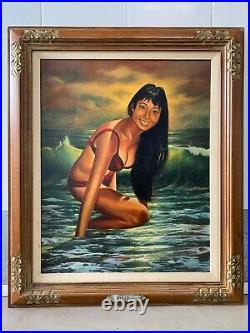
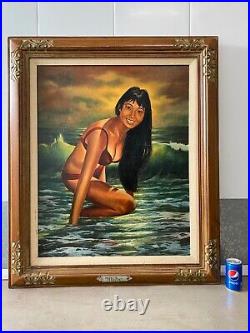
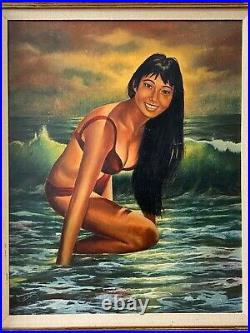
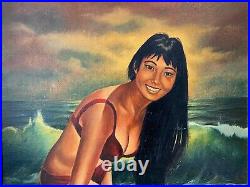

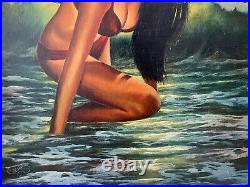
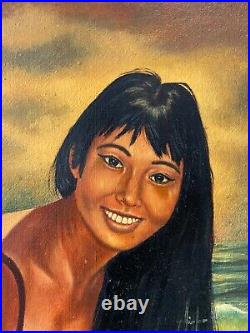
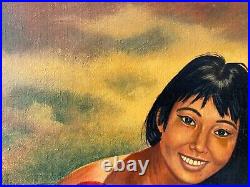
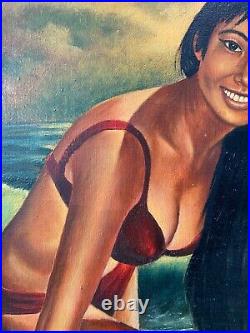
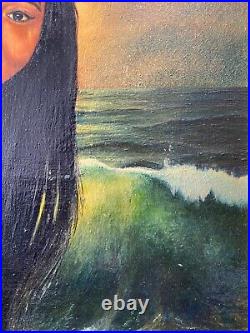
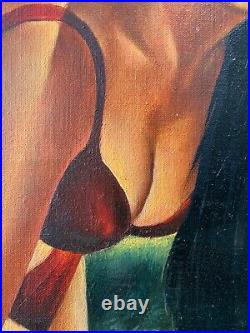
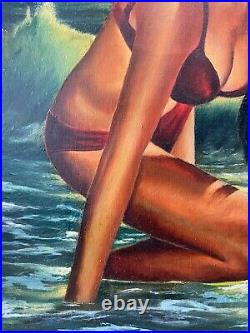
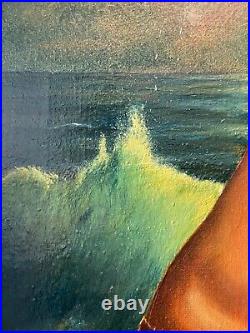
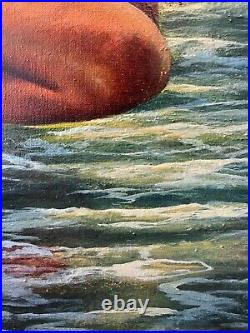
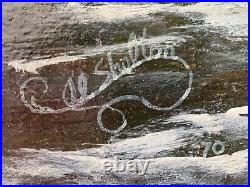
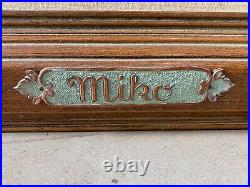
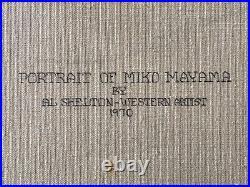
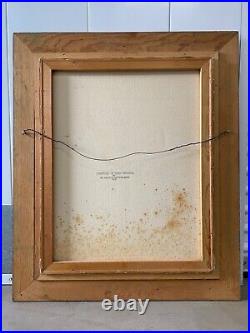
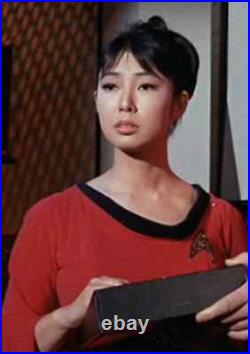
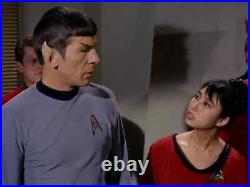
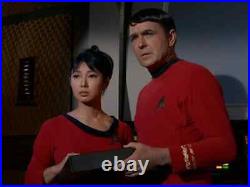
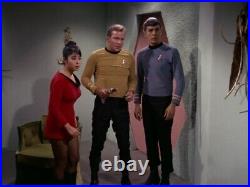
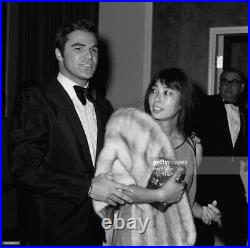
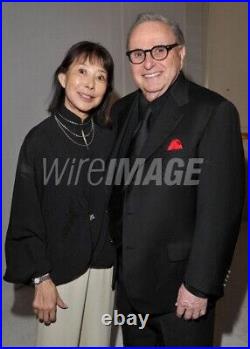


This is an important and RARE Vintage Star Trek Japanese Actress Oil Painting on canvas, by "Cowboy artist to the stars, " Al Shelton 1920 - 2016. This fine work depicts a bikini clad Miko Mayama, the first Asian-American woman on Star Trek (playing Yeoman Tamura,) film actress, and former love interest of Burt Reynolds. This work was almost certainly a gift from Burt Reynolds to Miko, since Reynolds had many custom belt buckles made by Al Shelton and knew the artist very well. Al Shelton is most renowned for his masterful and highly sought leatherworks, providing custom items for Gene Autry, Ricky Nelson, Clark Gable, Burt Reynolds, Dale Robertson, President Ronald Reagan, etc.
His oil paintings are perhaps his rarest creations, with only a handful ever coming up for sale. Even rarer is this full scale commissioned portrait, which even has a custom plaque at the bottom of the frame which reads: Miko. " Signed and dated: "Al Shelton 70 in the lower left corner. Additionally, this work is titled, signed and dated on the verso: Portrait of Miko Mayama by Al Shelton - Western Artist 1970.
This piece is without a doubt his finest known portrait work. Approximately 32 1/4 x 38 1/4 inches including frame. Actual artwork is approximately 24 x 30 inches. Very good condition for age, with some light edge wear to the original period frame.
She is an actress, known for Star Trek (1966), That Man Bolt (1973,) and Mannix 1967. Had a brief relationship with. Burt Reynolds and visited him in Georgia during the filming of Deliverance 1972.
Autobiography, "But Enough About Me", she started as a Kabuki Theater player. They met when he stopped in Japan on his way to the Philippines to do Impasse 1969. She moved with Reynolds to the US and learned to speak English by watching Bugs Bunny cartoons. Her first words to him in English were, What's Up, Doc? They lived together for four years before he left her for Dinah Shore.
Miko Mayama is the actress who played Yeoman Tamura in 1967 in the Star Trek: The Original Series first season episode "A Taste of Armageddon". Nikkei Influence in Star Trek.
Successful television & film franchises that span decades are few and far between. More so, ones that have consistently featured both Japanese actors and Japanese characters. It occurred to us while writing our previous post for American Mishima that featured Miko Mayama, that we overlooked a larger story of Nikkei in television & film. As a Science Fiction fan I've always loved Star Trek for it's inclusiveness of Aliens and other races.
In particularly when it originally aired at a time back in the 1960's when such roles for non-Caucasians were either few roles mostly delegated to playing out tired old racial & cultural stereotypes. Not so on Star Trek! Gene Roddenberry had a vision for the future that included people of all walks of life where people were treated as equals. While much has been written about the Nichelle Nichols break through the color barrier with her character Uhura, not so much has been written about the Nikkei of Star Trek. We at American Mishima decided to do something about that so here's our take on this overlooked issue.
Perhaps as with many veterans of that Greatest Generation, the experience of war changed their outlook on life and of their former enemies. Of all the non-Caucasian non-alien roles, Nikkei actors maintained an ever present presence on the Star Trek Franchise. So where did this start?
WWII or that first TV Pilot of Star Trek - The Cage? The Cage was Star Trek's original pilot that the network executives found "too cerebral" and mortified having a powerful female first officer (Majel Barret) and an alien officer (Leonard Nimoy) on the bridge of the USS Enterprise.
On no uncertain terms, either the alien goes of the woman goes. As the story goes, Roddenberry went with the Alien Vulcan and fired the woman #1 played by Majel Barret who as a concession for being fired was made his real life wife in a Shinto Wedding in Japan. It is noted that Roddenberry himself practiced no religion yet saw that since he had asked her to come to Japan that they would marry there in traditional Shinto ceremony. Not something you would expect from a man who once fought against Japan but there you have it. By the second re-launch of Star Trek, we would be introduced to America's most famous Nisei of all time George Takei in the role that dominated his career as Hikaru Sulu.
Hikaru Sulu most famously played by George Takei. He became a permanent character as the Enterprise's helmsman starting from the Second Star Trek Pilot all the way into the Star Trek motion pictures. His character would also rise in rank to eventually become the Captain of the USS Excelsior in Star Trek The Undiscovered Country. George Takei recalled Gene Roddenberry wanted the character to represent all of Asia, which symbolized the peace of the Trek universe in spite of the numerous wars in the continent. Roddenberry did not want a nationally specific surname, so he looked at a map and saw the Sulu Sea.
"He thought,'Ah, the waters of that sea touch all shores', " the actor recalled, and that's how my character came to have the name Sulu. Given the era that this took place the logic becomes clear. In the book Inside Star Trek The Real Story, the character's name is noted as a play on the name of vice president of Desilu Studios, Herb Solow. George continues to act and speaks regularly about his boyhood experiences of being being forcibly imprisoned in America's Concentration Camps during WWII as well as his many fan appearances at Star Trek events. Yeoman Tamura played by Miko Mayama appeared in only one episode of the original series A Taste of Armageddon.
As to how we feel about non-Nikkei playing Japanese roles I will best leave that to George Takei who in an article when asked about the creation of Demora Sulu, he stated: It's intriguing. I'd like to know how I had her. That's the thing about doing a long-lasting serialized film or TV series. You really are in the hands of the writers and the other molders and shapers of the series.
Japanese actors in Hollywood have come a long way to overcome cultural stereotypes over the years. And in some ways, they still have their work cut out for them. But to truly appreciate where they are today one must look back to the post war days where Hollywood was either clueless or simply assumed their audience was culturally ignorant enough not to care. It was this last Sunday during a late spring rainstorm that by chance we had been channel surfing when we came across a peculiar episode on TV Land of "The Flying Nun" that we noticed this likely long forgotten episode featuring American Born actress Miko Mayama.
What struck us right away was this Japanese girl playing a Korean named "Kim Ching" who was dressed in almost every scene in brightly colored silk Chinese Cheong san dresses that today people would not associate with Koreans. None the less, this momentary television curiosity had us glued like some train wreck we couldn't turn our eyes away from. Just how far would the writers make this American born actress Miko Mayama play out every racial & cultural stereotype in the span of twenty minutes.
Long story short, it was her cheery expression in her eyes particularly with every bow she made in her exaggerated accent that we wondered what indignity she was putting up with in order to work in this town. In nearly half her roles they could not even spell her name right including this Flying Nun episode. We at American Mishima felt bad enough for this girl to wonder what became of her and if she got to do anything else that would make today's Asian Acting Community cringe. Well this girl if she is still out there would be around 72 years of age and possibly still living in Los Angeles. Miko Mayama made her career in Hollywood during the 1960's and 70's. She had appeared in many television shows playing Koreans, Japanese, Chinese, or anywhere an Asian girl could get a break back then. She was quite a beauty in her day.
She is not listed as deceased but she did get a curious mention for being a girlfriend of Burt Reynolds during the 70's. While Miko Mayama may not have won any big awards for her acting, she should be credited for her groundbreaking work that opened the door for future Japanese-American & other Asian actors that followed. By chance Miko Mayama is still out there and reads this post we'd like to say on behalf of American Mishima, we salute you!
Miko Mayama (born August 15, 1939 in Kyoto, Japan) is a Japanese-American actress who was active in the 1960s and 1970s. Mayama made several film and television appearances from the mid 1960s to the late 1970s. Her films include Gokudo bozu nenbutsu hitokiri tabi (1969), On the Hunt for the Lost Gold (1969), The Hawaiians (1970), Amanda Fallon (1973), Jefferson Bolt - Traveller in Dynamite (1973) and Cage Without a Key (1975). 1965: Valentine's Day (Television series, a sequence). 1965: Wendy and me, a consequence (TV series).
1966: Hey, Landlord (TV series). 1967: F Troop (TV series), a sequence. 1967: Star Trek (episode: "A Taste of Armageddon", character: Yeoman Tamura). 1967: The War Wagon (The War Wagon). 1968: their appearance, Al Mundy (It Takes a Thief, the TV series, a sequence). 1969: Gokudo bozu nenbutsu hitokiri tabi.
1970: The Flying Nun, a consequence (TV series). 1970: The Hawaiians (film) (the Hawai ians).
1970: Matt Lincoln (TV series), a sequence. 1971: To Rome with love (TV series).
1973: The Bold Ones: The New Doctors (TV series), a sequence. 1973: Amanda Fallon (TV movie). 1973: Jefferson Bolt - Traveller in dynamite (That Man bolt). 1974: Kojak (Kojak, the TV series, a consequence). 1974: Mannix (TV series), a sequence.
1975: Cage Without a Key (TV movie). 1979: MASH (television series, follow 7x18).
Tooled leather, sculpture and painting. Al Lee (Albert) Shelton (Born 1920) is active/lives in California, Colorado. Al Shelton is known for Tooled leather, sculpture and painting.
He is known as the "Cowboy Artist to the Stars". One of Al's most famous customers was the late Gene Autry for whom Al made many leather and sculpted items. In fact, several creations of Al Shelton are on display at the Autry National Center (formerly the Autry Museum of Western Heritage). Specifically, a parade show saddle made for Dale Robertson, the star of the television series Tales of Wells Fargo.
Shelton went on to work as a cowboy. In Colorado, Wyoming, and Nebraska over the next three and a half years. Although most of the saddles he saw were rather plain, the occasional ornate saddle he would come across fascinated him and he wanted to teach himself how it was done.
He was anxious to prove himself and began trying a little too hard. The foreman's advice stuck with him; Al, you'll have to slow down!
Shelton decided to become a freelance leather artisan in 1945 and started his own business. After 5 years, he moved to his studio in Studio City, California where he enjoyed a little more solitude to be able to focus on his work.
Shelton also began teaching around this time. While instructing the likes of Lou Roth. At Pacific Arts and Crafts, Shelton began collaborating with Dick McGahen of the Craftool Company to publish a number of Doodle Pages and a pattern book. Operation Leather Carving was released in 1950, which featured a variety of floral patterns that highlighted Shelton's style of flowing lines and intricate leaves and flowers. Throughout his career, Shelton became well known within the Hollywood community, expertly crafting director's chairs, script covers, briefcases, belts, belt buckles, watchbands, and a plethora of other leather goods for films, television, and the Hollywood elite.
His designs were featured on album covers for Western artists such as Patsy Cline and his work has been displayed in prominent museums throughout the world, including the Gene Autry Museum of Western Heritage in Los Angeles. Regardless of his success, Shelton remained humble and dedicated himself to teaching others. His life work included the publication of well over 100 how-to articles in leathercraft magazines, most notably his "Tricks of the Trade" series.
In 2004, Shelton was awarded the prestigious Al Stohlman. Award for Achievement In Leathercraft. Fun Fact: In addition to leathercraft, Shelton taught himself bronze sculpting, oil painting, and water color painting. Although he kept himself too busy to self-promote much, his business cards were hand painted with water colors. Al Shelton: A Short Biography June 27, 1920 - March 22, 2016 by Wayne Christensen and Sandi Taylor.
Albert Lee Shelton was born on Sunday, June 27th 1920, in Greeley, Colorado. Al had two sisters and a brother. His mother passed away when he was 6 years old.
His older sister passed away when she and Al came down with scarlet fever following a school dance. She was 6 years his senior and taught him to play guitar, as she knew how to play piano, guitar and how to read music. He never had other formal classes or education other than those from his sister, along with some musician friends that he met over the years who helped advance his playing. As a child, Al had three passions: he wanted to be an artist, wanted to play guitar and wanted to be a cowboy. Throughout his life, he made this passions come to life. Al started doing leatherwork at 14 years old. He didn't know anything about it; he made his own tools and taught himself how to tool leather. The first project that he made was a holster for a pistol that he had made out of a rifle.
He sawed off the rifle and made a pistol handle for it. While working on breaking a thoroughbred that the owners wanted to be a racehorse, Al met his future wife, Katherine. Seeing the disappointment shown from Katherine's parents, he knew he had to get a good job to better himself. He washed dishes and was a night watchman for a while.
After the birth of his daughter, Loretta May Shelton, Al worked at Schwayder Bros. In Denver in 1942, breaking horses for his keep. Then he got a job at Gates Rubber Company, making civilian gas masks, where he quickly moved up to assistant foreman. In 1943, Al walked into the Powder River Saddle Shop in Denver. He was trying to carve but he didn't have a place to work or a chance to do anything with it. Al had just been pushing the tools; he didn't know they were supposed to be hit with a mallet. Having another looky-loo did not make the staff happy. He showed one of the carvers a billfold he had made and the carver called the foreman over who offered him a paid apprenticeship for 4 years. He would start in a week and be paid 50¢ an hour with periodic raises.
" The foreman said, "Learn to do it good first, good as you can, and then speed will come. When Al received his first paycheck, he found that he had gotten 60¢ an hour instead of the 50¢ they had originally agreed upon. From watchbands, he moved on to belts. After 11 months with Powder River, Al wrote to Edward Bohlin at Bohlin Saddlery, sending samples of his work and requesting a job.
Not sure of his capabilities, Al took a side trip to Rowell Saddlery in Hayward, California at the same starting pay. Three months later, after the head leatherworker kept trying to get him fired, he left Rowell Saddlery. It was then that he went to Bohlin Saddlery and began to work for the "World's Finest Saddlery". This "touched his heart", that he was considered satisfactory from the start. His job on the billfolds was putting on the decorative cuts. The job with Dave only lasted 4 months as well, but not by Al's choice. It was then that he chose to start out on his own, but with winter coming on, he needed to find somewhere to be indoors. He went out to San Gabriel to see the people at Weston Saddlery, where when interviewed, was asked to make the owner a belt. When he did, the offer was made for him to move in. He would do the Weston's work wholesale, and get to do his own custom orders. Soon after, in the spring of 1948, Al was offered the chance to move to the Farmer's Market on 3rd and Fairfax.
Moving on was not an easy decision for Al, but the opportunity that he felt awaited him overtook the offers of free rent and rent reduction and he made the move. While at Farmer's Market, he was asked to teach a class at Compton Junior College in Compton, California. Having dropped out of school in 9th grade, Al did not have much of an education or teaching credentials, but through reference letters sent by the principal to Sacramento, he received his credentials. He taught a leathercraft class for 5 years, while also working at Farmer's Market.
During his time at Farmer's Market, Al created a photo album notebook for Harriet Nelson. Some years after moving into the Studio City shop, Rick Nelson's brother, David, brought him into the shop because Rick had seen Elvis Presley's leather covered guitar and wanted one for himself. Al ended up making four leather guitar covers for Rick Nelson. While he was making the original cover, Rick would come to see him. Al would teach Rick chords on the guitar because he had never played before.
Following his time at Farmer's Market, Al connected with Nudie Cohn. Al spent the next 5 years doing leatherwork for Nudie's Western Rodeo tailors. These were busy years of creating not just with leather, but also buckles and paintings like one for Audie Murphy. After 5 years of teaching, the school moved to a new building and he wasn't asked back. He taught advanced classes in leatherwork for 2 years at his shop, which at the time was across the street from Farmer's Market, where he worked for 4 years before moving to his well known shop on Ventura Boulevard in the heart of Studio City in the fall of 1957. Al had a couple of his paintings in the offices of the Gunsmoke series, but he didn't have any of his leatherwork being used by them since the time frame of the show required plain leather with no intricate work done to it. They later wanted Al to create a buckle for them. He had never carved in wax but he told them he would see what he could do and let them know in time to find another artist if he was unable to create a quality project.
However, the largest buckle order came from Tom Selleck for the cast and crew of Magnum P. When he ordered 350 silver buckles.
In September of 1976, the Stuntmen's Association of Motion Pictures made Al Shelton an honorary member in appreciation of his unselfish contributions and the great friendship between him and the stunt men. Continuing on the road of discussing the buckles he created, I'll take a detour to tell you about how I met Al. We met about 25 years ago. I was commissioned by Great Western Savings to reproduce the check book that Al had made for a commercial of theirs. Great Western told me that they didn't know how to get a hold of the original artist that had made the checkbook, so I took the job.
As I was working on the mock-up, I found Al's name on the back of the original checkbook. At that time, I didn't know many of the great masters, so the name did not mean anything to me. I was also working on another job for a friend, and I opened up a belt buckle box to put the buckle on a belt I was making and there was the same artist's name with a business card from Studio City, right here in town! I went down to the local leather shop and asked them if they knew who he was. They did, and I told them I had to go and talk to this guy since he was right in town. I went down to his shop; Al was at his bench working on something. I walked in and Al flipped it over, came around his bench and a guy that looked as tall as me behind the bench was actually just a little, short guy. I introduced myself, handed him the checkbook, and said, "I understand you made this".
I apologized for not knowing who he was and let him know I was new at leather to which he replied, Well you can't be too new if you can reproduce my work! We talked for awhile and I told him I was going back to Great Western to give them his card and tell them where to find him. (Up to this point, Al was shifting his weight from one foot to the other and all puffed up like a little bantam rooster and I was afraid this old man was going to swing at me or something). Instead, he stopped dead, stuck out his hand and said, I'm proud to know you!
I backed up a bit, confused by his actions, because a minute before he was ready to hit me. He said, In our business, there are no ethics, my competition would cut my throat just as quick as they can. He gave me a tour of his shop and showed me all there was to see before I went on my way. From that day on, Al was an exceptional friend.
After that initial meeting, I went back to Great Western and told them how to get a hold of Al. This didn't make them very happy; turns out they knew how to get a hold of him but wanted someone who would work cheaper. Eventually, they asked me to submit a new pattern, and I agreed. I called Al and let him know what had happened; he already knew because they had called him to ask for a lower-priced pattern. I asked if that would cause an issue between us to which he replied no; he wasn't afraid of a little competition and did not consider me his competition. I went to visit Al about a month later and he said, I'm glad you're here. " My first thought was, "What did I do now? He reached up on his shelf and pulled down an envelope with my name on it. I said, What's this for, Al? THAT is they kind of guy Al Shelton was - loyal to his friends, always speaking his mind and brutally honest, especially when it came to critiquing your leatherwork. He'd tell you what you were doing right - and what you were doing wrong - but he was one great guy! There are quite a few items made by Al Shelton at Autry National Center, formerly Gene Autry Western Heritage Museum, including guitar cases, briefcases made for Gene, as well as the La Rosa Florentine parade saddle made for Dale Robertson, the star of the television series "Tales of Wells Fargo", featuring John Frederick Herring's famous pharaoh's horses. The most visible and recognizable piece of work at The Autry was a joint effort by DeL'Espri and Al Shelton on the statue of Gene Autry and Champion "Back in the Saddle Again", which sits in the museum courtyard. DeL'Espri sculpted Champion & Gene, while Al did all of the leather carving - the boots, gun belt, saddle, bridle and bridle bit (which are engraved with six shooters). Al won the prestigious Al Stohlman Award for Achievement In Leathercraft on May 22nd, 2004, during the Rocky Mountain Leather Trade Show. The award is given to a person whose accomplishments in leatherwork show dedication to the furtherance of leathercraft - one who demonstrates continued dedication by promotion and improvement of the craft, following the example of world-renowned leather artist and author Al Stohlman. The many articles giving guidance to those new to leathercraft were written by him for The Craftsman and Make It With Leather magazines where he shared his experience, his patterns and his work to inspire and teach others about leatherwork. The dozens of tools he designed and the pattern packs and leather art books with his unique style of carving, which he created for Dick McGahen of the Craftool Co. Are only a few of the things Al brought to the world of leathercraft. They only begin to show his eligibility and the reason he was given this prestigious award. His last major leather masterpiece was a guitar cover commissioned by the Martin Guitar Company in 2005.
He demonstrated with other members at early "Leatherama" events, and, through his pattern packs, books, articles and tool designs promoted interests in the art of leatherwork in its many forms, which is what The Leathercraft Guild is all about. In June of 2010, Al joined The Leathercraft Guild at the demonstration booth set up in the courtyard of The Autry during his 90th birthday celebration for his final guild event. The Guild presented Al with a handcrafted leather plaque for his lifetime achievement in the world of leather. He at the same time received a commemorative plaque commissioned by the Longhorn Trail Leather Guild with the design of Al's "Sheriff of Ulcer Gulch". In July of 2011, guild member Anne Newkold surprised the guild members by bringing Al to his final guild meeting, where he told stories, shared his music and joined in the leathercraft fellowship with those in attendance.
A certificate of recognition was presented to Al by the Studio City Neighborhood Council on Wednesday, July 18, 2012 for his creative talent, his loyalty to Studio City as a business owner and his longevity in and dedication to Western Culture. He also received a certificate of congressional recognition from Congressman Howard Berman during the Congressional Town Hall Meeting in the North Hollywood High School auditorium on July 30th, 2012. A special thank you needs to be made to Greg M. Atkin, who referred to Al as "the most versatile western artist of the last century". Through Artisan Studioworks, Greg brought Al's stories and music to life in the Al Shelton Living History 2 CD set.
Before bringing us the CD set, he assisted Al in a longtime dream of getting his artwork into print for sale and display in galleries. Al referred to Greg as "his Man". Greg he was not only Al's business partner in art but he was a good friend to him.
Greg was influential in helping get media coverage for Al's story. He planned and directed social events for Al over the years.
Some of the events he had a hand in include a Martin Guitar party when he finished his final leathercraft project, his 90th birthday at The Autry, his appearances at the Santa Clarita Cowboy Festival, his 95th birthday party last year and many other events, since their meeting in 2004. Al passed away peacefully the morning of March 22nd, 2016 with his daughter, Loretta, by his side. He was laid to rest at Pierce Brothers Valhalla in North Hollywood, CA on March 30th. There was no media coverage, no celebrity outpouring and a small presence of those who loved him (about 30) attending his burial. The funeral home had instructions for immediate burial but, including me, upwards of 60 other people called inquiring about the services.
Although all were told that there would be no tent, no chairs, no memorial cards, etc. And that it would just be the ground crew burying him, we were welcomed to come. Atkin made memorial cards, brought Al Shelton's living history CD sets, and leather fobs with the "Sheriff of Ulcer Gulch" stamped on them. Chuck Smith Tools (Chuck and Lana Smith) and Mrs.
Jean Atkin of Mission Viejo contributed a beautiful flower wreath holding a picture of Al. To our surprise, the funeral home set up a tent, chairs, gave us water, tissues, dirt, individual flowers to place on the casket and 30 minutes for our own service. Greg Atkin spoke first and directed the service. The director from Inn on the Boulevard Retirement Living, where Al last stayed, a few others, and I all spoke.
We also heard a few tracks from the music portion of Al's living history CDs. We truly sent Al Shelton off in style with respect and dignity. There are plans for a celebration of life later this year at either Standing Bear's Trading Post or The Autry National Center where his art can be displayed, and he can be celebrated.
I own Standing Bear's Trading Post, a small leathercraft supply store, where I teach classes 5 nights a week to continue advancing the art of working with leather. I met Al in the mid 80s and we were good friends from our first meeting until he passed away. Sandi Taylor - I have been doing leatherwork for 20 years under the tutelage of Wayne Christensen. I met Al during one of Wayne's many visits to Al's leather shop in Studio City. I enjoyed spending time with him as I learned of his history in leather.
And that's OK by him. These days, Shelton, 84, onetime cowboy artist to the stars, would be just as pleased with the company of a stray cat. In the dinky backroom of his curio-crammed storefront, Shelton polishes off lunch -- one slice of white bread, bologna, catsup -- then ambles toward his workbench to scrutinize the intricately tooled leather covering he's making for the Martin Guitar Co. S new museum in Nazareth, Pa.
Martin commissioned the piece on the strength of a leather-tooled cover for a guitar Shelton carved for Ricky Nelson in 1957. The yellowing tracing paper for that rosette and scroll design lies in a pile of old notebooks, photographs and articles. "I don't have much of a filing system, " rumbles Shelton, his raspy twang sounding like it's been filtered through a slurry of gravel, whiskey, barbed wire and tumbleweed. I'll tell you how that worked out: Ricky wasn't old enough to drive, so his brother, Dave, brought him here and told me they saw Elvis Presley and wanted a guitar like his. I sort of put a little act on'em.
I said,'No way would I try to duplicate Elvis.... But I'll be glad to do a better job than that! Shelton befriended the young teen idol and even taught Nelson a few chords on the guitar. Three months go by and Rick comes back here to show me how he was doing, playing all these fancy runs.
Boy, he just passed me up like a dirty shirt, and I started learning from him. Flanked by an Indian restaurant, dry cleaner and adult video store on a stretch of Ventura Boulevard marked with a "Gilligan's Island" plaque, the Al Shelton Western Artist store comes across as a Wild West diorama, stuffed with midcentury treasures.
Because of the time-consuming Martin Guitar project, Shelton is not taking orders for new work. However, he says, people are welcome to drop by. "This place is like a museum, has been for years, " he says. Now, he'll consider offers. My latest decision is, I can't take this stuff with me, and I'm getting on the old-ish side, you know. So anybody's serious and they want some of this work, they gotta make me an offer. If I think it's a fair price, they can have it. Scattered amid the horseshoes, lariats, wagon wheels and leather-relief portraits of Will Rogers are more recent artifacts. Sly Stallone's boxing gloves, used as the model for a "Rocky 2" belt buckle, hang near Shelton's bench. A letter from Reagan gathers dust beneath a glass case, along with buckles commemorating Burt Reynolds' football team and Tom Selleck's Magnum P.
I just tended to my own business. Every job, I did the best I could, because every job, my reputation's at stake. You start cutting corners, something like that travels fast too.
Assuming a splay-legged stance behind the same workbench where he once took a belt order from Gable, Shelton selects a nail-shaped stamping tool of his own design, picks up a baton mallet and hammers a delicately dimpled pattern into a swatch of cowhide. He still possesses the smooth, pink hands of a 25-year-old, but decades at the bench have taken a toll on his hearing. "You're pounding down the background so the design is actually raised up, " Shelton explains. That's basically what's the matter with my ears.
I've got 80% hearing loss. All this pounding, pounding, pounding. Shelton also has eye problems caused by a near-fatal 1936 car crash. "That pretty near killed me, " he says.
I was supposed to stay in bed until my vision got better. You can't stay in bed all that time when you're 16! So I still have double vision.
Just this morning I had a flash. Well, I don't want to worry about it.
I'm hoping to get this guitar carved before I get too far gone. Shelton's friend and protege Brennan Byers, who crafted the leather gear used in the movie "Pirates of the Caribbean, " describes his mentor as an uncommonly gifted artisan schooled in a nearly extinct code of honor. "He's a piece of living history, " Byers says. You tell some teenager that somebody you know broke horses for the U. Army, they look at you like you're from Jupiter. Started in a saddle shop. Shelton grew up in a small Colorado town, quit school at 14, hit the road three years later during the tail end of the Depression and wound up at a Wyoming ranch herding cattle and taming wild horses.
Shelton married briefly -- his daughter lives in Seattle -- before finding his metier at a Fort Collins, Colo. He remembers, I went up to the head carver, showed him my billfold I'd done a little work on, and he said,'That's pretty good; how would you like a job doing this? So I started at 50 cents an hour, which wasn't that bad in those days. I caught on pretty quick.
He set up shop in Studio City just as TV westerns were taking off. Actors pretending to be cowboys at the nearby production lots were thrilled to have Shelton lend a stamp of authenticity to their belts and leather-backed directors chairs. Shelton later took up oil painting and in 1972, he devised his own system for sculpting detailed wax miniatures used to cast limited-edition bronze belt buckles. "This new business kept me going nearly full blast for 10 years, " Shelton says.
Then, like a change in the weather, westerns died and so did buckles. When he was 68, Shelton contributed the boots, saddle work and holsters for the Gene Autry "Back in the Saddle Again" sculpture at the Museum of the American West, which owns four other pieces as well. "Probably the most spectacular thing we have is a saddle he made for the TV program'Tales of Wells Fargo,' " says Michael Duchemin, a senior curator at the museum. The leather is carved to have a filigree effect and there's a gold foil laid down underneath it, so when that saddle was on a horse and the star, Dale Robertson, was riding, that gold foil would sparkle in the sun showing through the carved leather work. The level of intricacy is just amazing. Who would be insane enough to take the time to do all that work? It's a labor of love that reminds me of some of the really intricate Chinese craft.
An unexpected guest comes through the door. It's Paul Marshall, a studio musician from Tujunga.
The pair start strumming, immune to the cars whizzing by outside. A few shafts of late afternoon sunlight penetrate the old man's shop as Shelton rears his head back and begins wailing the 1957 Roy Acuff ballad Blue Eyes Crying in the Rain. Love is like a dying ember. Through the ages I'll remember.
Blue eyes crying in the rain. "That's a beautiful little song, " Shelton mutters. I've been doing it for a while. A lot of people cry when I do this song. Maybe, like me, they just cry easy.
Old West Artist Still Creating in Los Angeles. When Western artist Al Shelton first set up shop in Los Angeles, there was sagebrush behind his store. Today, Ventura Boulevard is home to strip malls and franchised retail outlets. A lot has changed in Shelton's neighborhood in 50 years, but inside his store, well, that's another story, one that reporter Gloria Hillard stumbled upon just the other day.
GLORIA HILLARD: The first thing you notice is a hand-carved sign that reads Western Artist. In the window, catching the morning sun, is a well-fed orange cat sprawled next to a white cowboy hat. And if you were to step closer to the storefront, shade your eyes and peer inside, chances are you'd get a glimpse of the 86-year-old artist at work or play. HILLARD: For 50 years, this is how Al Shelton has been starting his day, here at his studio store and place he calls home. AL SHELTON (Artist): (Singing) (Unintelligible). HILLARD: The former cowboy from Colorado is self taught on the guitar.
Others are sculpted in bronze. But it is the intricate hand-tooled leather art he is best known for. Shelton says he first fell in love with the leather tooling when he worked as a ranch hand as young man, admiring the hand-carved saddles of well to do cowboys.
SHELTON: I thought it was beautiful. I'd follow the lines, you know, so graceful, and then I wanted to do it. HILLARD: And so he did, bringing that talent with him to Los Angeles in the late'40s. He started out working for the famed Nudie's Rodeo Tailors, the store that outfitted everyone from Roy Rogers to Elvis Presley.
SHELTON: Well, they were real famous in the old days, and all of the big people were going to Nudie's for his fancy shirts and my fancy guitar cases, briefcases, my fancy leather work. HILLARD: One of Nudie's most famous customers back then tracked Shelton down, a cowboy by the name of Gene Autry. SHELTON: Well, I did quite a bit of work for him. I started doing his work in'53. I did a guitar case for him. He has it over there. HILLARD: By over there, he means the Autry's Museum of the American West in Los Angeles, where a number of Shelton's leather and bronze art pieces are part of the museum's permanent collection. Around his waist is one of his famed belt buckles. Worn cowboy boots rest on aged linoleum. It's hard to match the balding man with the gray stubble to the framed oil painting of a cowboy sitting on a black and white pinto, or the one just thrown by a bucking horse.
Every painting has a story and every story is told in great detail. SHELTON: And boy, if I thought she was a bucking horse yesterday, I didn't know - she just bucked so hard, but I was staying right with her. Extra low and then she came up with such force.. HILLARD: Shelton made his last painting in 1991, because of his eyes, he says.
But at his leather workbench is a custom guitar cover for a Martin guitar. Aged hands work patiently on the almost filigreed-looking design that he traces lightly. SHELTON: Raised centers - you never see any work like that around.
HILLARD: At the center of the elaborate designs, he's carved and painted a small picture of a young singing cowboy, guitar in hand. SHELTON: That's me and my horse, Buck, and my cat, Teddy. HILLARD: He's been working on the piece for a couple of years, and it bothers him that it's taking so long to finish. On Ventura Boulevard, the sun is going down, and for Shelton that means ending the day the way he started it. SHELTON: (Singing) Remember me when the candlelights are gleaming.
Remember me at the close of a long, long day. HILLARD: For NPR News, I'm Gloria Hillard. SHELTON: (Singing) It'll be so sweet when all alone I'm dreaming, just to know you still remember me.
June 27, 1920 - March 22, 2016 Albert Lee Shelton, 95, passed peacefully on Tuesday, March 22, 2016 at his retirement residence, The Inn on the Boulevard, in Studio City, California. He was born on June 27, 1920, in Colorado to Joshua D. (Bay) Shelton, both from Missouri. Al was a cowboy and ranch hand in Colorado, Wyoming and Nebraska. He began his leather carving career at the Poudre River Saddlery in Colorado, and then he moved to California in 1943 to work for Bohlin Saddle Makers.
He was well loved, and his charm and genuine character will be missed by many in the community. Al is survived by his daughter Loretta M. Green of Seattle, WA, granddaughter Lisa J. Green of Portland, OR, and great-granddaughter Cassandra L. Kimmel of San Diego, CA. He is also survived by seven nephews and nieces: Larry Gardner, Jerry Gardner, Dan Gardner, Doug Gardner, Judy Johnson, Karen Rodriguez, and Anne Shelton. He was preceded in death by his parents, his brother Harold, two sisters Leland and Elsie, and his former wife Katherine M. Published by Los Angeles Times from May 11 to May 15, 2016. This item is in the category "Art\Paintings". The seller is "willsusa_utzeqm" and is located in this country: US. This item can be shipped to United States.
- Artist: Al Shelton
- Signed By: Al Shelton
- Size: Large
- Signed: Yes
- Title: \
- Material: Canvas, Oil
- Region of Origin: California, USA
- Framing: Framed
- Subject: Actors, Celebrities, Portrait, Television, Women, Science Fiction, Star Trek, Hollywood, Film
- Type: Painting
- Year of Production: 1970
- Original/Licensed Reproduction: Original
- Item Height: 38 1/4 in
- Style: Modernism, Realism, Portrait
- Features: One of a Kind (OOAK)
- Production Technique: Oil Painting
- Country/Region of Manufacture: United States
- Handmade: Yes
- Item Width: 32 1/4 in
- Culture: Japanese
- Time Period Produced: 1970-1979

